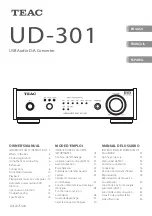
AT-MCF2000 Media Converter Series Installation Guide
Section I: Features
39
diagnose the problem. Rather, you should use the Link Test or the Smart
MissingLink modes to troubleshoot a link problem.
Smart
MissingLink
Mode
The Smart MissingLink mode, the third operating mode of the media
converter channels, is nearly identical to the MissingLink mode. It, too,
enables the ports of a channel to pass the “Link” status of their
connections to each other so that both ports reflect the same link status.
The difference is that when a port in a channel loses its link to its network
device, this mode does not completely shut off the transmitter on the
companion port. Rather, it pulses the port’s transmitter and blinks the
port’s Link LED every second. This signals that the port can still establish a
link to its network device and that the loss of the link originated on the
other port in the channel.
This difference allows you to use the Link LEDs of the ports to
troubleshoot a link failure. In contrast, when a channel is operating in the
MissingLink mode you cannot use the Link LEDs of the ports to
troubleshoot a link problem because both LEDs will be off when one port
does not have a link to its network device.
For definitions of the Link LEDs when a channel is operating in this mode,
refer to Table 10 on page 45.
Here is an example of how the Smart MissingLink mode works. Assume
that the fiber optic port in a media converter channel lost its link to its
network device while the channel was in the Smart MissingLink operating
mode. The mode would respond by pulsing the transmitter on the twisted
pair port of the channel about once a second, and flashing the port’s Link
LED. This would signal that the twisted pair port can still establish a link
with its network device and that the failure originated on the fiber optic
port. When the connection is reestablished on the fiber optic port, the
twisted pair port resumes normal operations so that the two ports can
again forward traffic to each other.
The operating mode functions the same if the failure starts on the twisted
pair port in a channel. Here, the mode pulses the transmitter on the fiber
optic port and blinks the port’s Link LED.
As with the other two channel operating modes, this mode does not
interfere with the flow of network traffic through the ports of a channel
during normal network operations. However, you might want to limit its use
to diagnosing a link failure, particularly if the network devices connected to
the ports are managed devices. This is because the pulsing of the
transmitter on a port and the constantly changing status of a link could
prove problematic for some managed devices. For example, the device
might send a constant stream of SNMP traps or, if the device is running a
spanning tree protocol, the protocol may become confused as the status of
the device’s link to the media converter constantly changes.
Содержание AT-MCF2000
Страница 8: ...Contents 8...
Страница 12: ...Tables 12...
Страница 18: ...Preface 18...
Страница 20: ...20 Section I Features...
Страница 26: ...Chapter 1 AT MCF2000 Multi channel Media Converter Series 26 Section I Features...
Страница 54: ...Chapter 3 AT MCF2012LC AT MCF2012LC 1 and AT MCF2032SP Modules 54 Section I Features...
Страница 72: ...Chapter 4 AT MCF2000M Management Module 72 Section I Features...
Страница 84: ...Chapter 5 AT MCF2000S Stacking Module 84 Section I Features...
Страница 86: ...86 Section II Installation...
Страница 90: ...Chapter 6 Reviewing the Safety Precautions 90 Section II Installation...
Страница 92: ...Chapter 7 Selecting a Location 92 Section II Installation...
Страница 96: ...Chapter 8 Unpacking the AT MCF2000 or AT MCF2300 Chassis 96 Section II Installation...
Страница 98: ...Chapter 9 Removing the Rubber Feet 98 Section II Installation...
Страница 106: ...Chapter 11 Installing the AT MCF2KFAN Module 106 Section II Installation...
Страница 110: ...Chapter 12 Installing a Media Converter Module 110 Section II Installation...
Страница 122: ...Chapter 15 Installing the Chassis in an Equipment Rack 122 Section II Installation...
Страница 128: ...Chapter 17 Installing the SFP Modules in the AT MCF2032SP Module 128 Section II Installation...
Страница 130: ...Chapter 18 Cabling the Ports on the Media Converter Module 130 Section II Installation...
Страница 134: ...Chapter 19 Cabling the AT MCF2000M and AT MCF2000S Modules 134 Section II Installation...
Страница 138: ...Chapter 20 Powering on the Chassis 138 Section II Installation...
Страница 156: ...Chapter 23 Troubleshooting the Modules 156 Section II Installation...
Страница 186: ...Appendix C Cleaning Fiber Optic Connectors 186...
Страница 190: ...Index 190...
















































